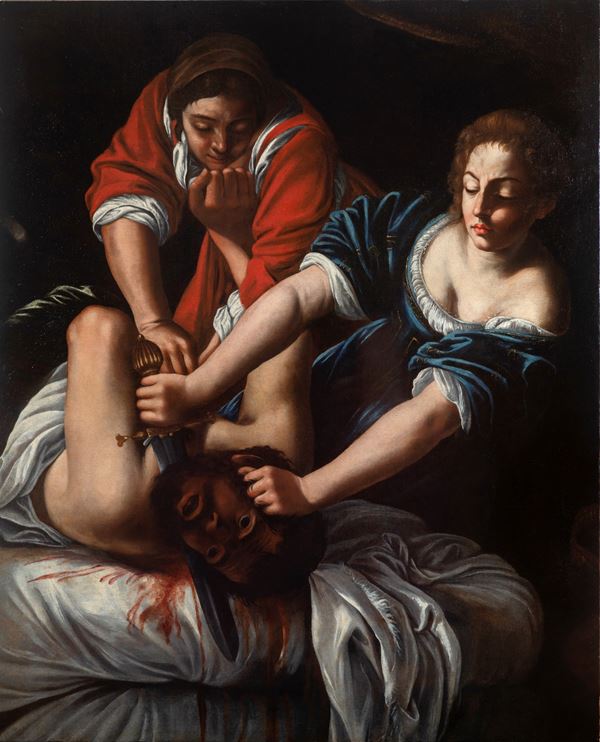43
Bottega di Artemisia Gentileschi (con interventi autografi dell'artista) (1593 - 1653)
Judith beheads Holofernes, 1612 - 1617
Oil on canvas
152 x 126 cm
The work, depicting Judith beheading Holofernes , derives from the same cartoon from which the masterpiece preserved today at the Capodimonte Museum in Naples was taken.
The version presented here, executed in Artemisia's workshop, shows some autograph interventions by the artist recognizable in specific details such as the arm holding the scimitar, where the anatomical rendering and expressive intensity are particularly marked.
Although the overall quality of the work differs from the Neapolitan painting, these interventions give the scene a personal touch and an intensity that makes the work superior to the productions attributable to the workshop alone.
The theme, taken from the Old Testament, is one of the most powerful and dramatic representations of Baroque painting, full of symbolic and emotional meanings. The episode is based on the biblical story of Judith, an Israelite widow who, to save her people from the Assyrian invasion, sneaks into the camp of General Holofernes, seduces him and beheads him while he sleeps.
Artemisia, through her version of this story, creates an intense and realistic representation, which stands out from the traditional interpretations of this theme. Although the figure of Judith was often represented in art as an elegant and virtuous heroine, Artemisia portrays her as a strong, determined and physically powerful woman, capable of facing with courage and determination the violent act of Holofernes' beheading.
We are grateful to Prof. Riccardo Lattuada for his help in attributing the work.
The painting is provided with a certificate of free circulation.
The version presented here, executed in Artemisia's workshop, shows some autograph interventions by the artist recognizable in specific details such as the arm holding the scimitar, where the anatomical rendering and expressive intensity are particularly marked.
Although the overall quality of the work differs from the Neapolitan painting, these interventions give the scene a personal touch and an intensity that makes the work superior to the productions attributable to the workshop alone.
The theme, taken from the Old Testament, is one of the most powerful and dramatic representations of Baroque painting, full of symbolic and emotional meanings. The episode is based on the biblical story of Judith, an Israelite widow who, to save her people from the Assyrian invasion, sneaks into the camp of General Holofernes, seduces him and beheads him while he sleeps.
Artemisia, through her version of this story, creates an intense and realistic representation, which stands out from the traditional interpretations of this theme. Although the figure of Judith was often represented in art as an elegant and virtuous heroine, Artemisia portrays her as a strong, determined and physically powerful woman, capable of facing with courage and determination the violent act of Holofernes' beheading.
The scene is full of drama; Judith is seen holding the Assyrian general's head with one hand, while with the other she holds her scimitar to strike him. Holofernes, who is lying on the bed, is depicted in a contorted and suffering pose, with an expression of terror and desperation. The contrast between Judith's calm determination and Holofernes' vulnerability creates a very strong visual and emotional impact.
The central theme of the scene is justice through revenge. Judith, while committing a violent act, defends her people from oppression and destruction. Artemisia, through this representation, not only tells a biblical story, but also gives it a universal meaning: the fight against injustice and the abuse of power.
We are grateful to Prof. Riccardo Lattuada for his help in attributing the work.
The painting is provided with a certificate of free circulation.
€ 40.000,00 / 60.000,00
Estimate
40.000,00 €
Starting price
€
Your bid
(The reserve price has not been exceeded)
(The reserve price has been exceeded)
Set your maximum bid

